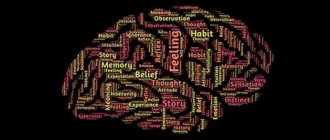Test is a synonym for "cup" and comes from Old French. The vessels made of baked clay that alchemists used for their experiments were called “tests”.
In Russian this word had two meanings:
- A religious oath, a probationary oath taken by a person entering into public office, thereby proving that he is not a secret Catholic;
- The second meaning is a flat smelting vessel that was used to separate tin from gold or silver.
As a psychological term, “test” appeared at the end of the 19th century. The term test is used along with the term methodology, and in the 1970s, when Soviet psychodiagnostics was being established, the term had a negative meaning, denoting its “bourgeois origin.” At that time, all tests were renamed methods. In our time, there is no reason to abandon this term-concept, with which the entire history of psychodiagnostics is connected.
It is quite clear that, like any cognitive tool, the test has its own characteristics. Depending on the specific circumstances of the study, the features of the tests can be considered as its advantages or disadvantages.
The effectiveness of using tests will depend on taking into account many factors:
- The theoretical concept that is the basis of a particular test;
- Scope of its application;
- A set of information determined by standard requirements for psychological tests and psychometric characteristics.
It must be said that the well-known ideas about the “simplicity” and accessibility of tests do not correspond to reality at all. The test, being a means of studying the most complex mental phenomena, cannot be interpreted simplistically as a proposal of a task and registration of its solution. Only if one relies on general psychological knowledge, competence in the theory and practice of relevant research, is the scientific use of tests possible. In addition, it is important to follow the ethical standards of psychodiagnostics.
Thus, a psychological test is a standardized task. Its results speak about the psychophysiological and personal characteristics, knowledge, skills and abilities of the subject. Psychological tests have their own areas of application:
- Diagnosis of mental states and personality traits;
- Diagnosis of interpersonal and family relationships;
- Diagnostics of professional personnel selection.
Testing methods
When selecting personnel, it is important for the employer to obtain complete information about the candidate - from potential to psychological inclinations. To do this, companies use a psychological job test that evaluates, depending on the developer, from 1 to 32 personality factors. The assessment of each factor indicates the candidate’s predisposition to certain behavioral models.
Example of a short psychological test:
Go through Prepare
Each employer determines its own set of factors required for a position.
There are two basic methods for determining personality traits:
- projective,
- multifactorial questionnaires to determine personality type.
Projective techniques
The method is based on an associative approach. The assessment of personal qualities is based on psychodiagnostics. Individual traits are not identified here, but a general assessment of the personality is given.
The method is based on creating a situation in which external stimuli stimulate mental processes within the individual. One of the most recognizable psychodiagnostic assessment methods is the Rorschach .
Example image from a Rorschach test
Psychodiagnostic methods use various elements that will have to be supplemented, continued or interpreted. For example, abstract images, colors, text, etc.
Applicants will have to:
- interpret stories in pictures;
- complete unfinished sentences;
- describe an abstract image, or schematically depict this or that plot yourself.
The associations that applicants make are considered to be a direct reflection of experience and behavioral patterns. Thus, employers receive a rough picture of each person's personality, indicating the person's positive and negative qualities.
Projective techniques have one advantage:
- There is no possibility of adjusting your answers in such a way as to create a positive opinion about yourself.
But the disadvantages
much more:
- Difficulty in interpreting the results. To evaluate a candidate, we need recruiters with psychological education.
- It takes a lot of time to evaluate one person.
- The overall “personality picture” of the candidate is assessed, not individual qualities.
- A little information for employers.
Because of these shortcomings, employers use projective techniques only as an adjunct to testing, after the decision to hire an employee has been made.
Types of tests based on the projective method
Luscher test - eight-color, multi-color
Example of flowers from Luscher test
The 8-color Lüscher-Test is based on the relationship of selected colors with character traits, aptitude for specific professions, mood, and performance.
For color characteristics, 4 basic colors and the same number of additional colors are required. Characteristics of colors in the Luscher test
| Colors | Values |
| Blue | Correspondence; sensitivity; calmness; unity; agreement; Adoption; Love. |
| Blue-green | Independence; prudence; effort of will; stubbornness, authority, self-control. |
| Red-yellow | Independence; will; onslaught; experience; success; action. |
| Yellow-red | Extravagance; happiness; expectation; novelty; search; movement. |
Comment:
In a conflict-free state, basic colors occupy the first 5 positions and characterize his emotional state.
Additional:
- purple - anxiety, stress;
- brown - experiences;
- black - fear;
- zero - disappointment.
These colors speak about the negative sides of the personality.
Rorschach testing and other similar tests are used in clinical psychology and psychiatry, and are rarely used in the original form for hiring. Most often, candidates are asked to choose one image from those presented, or sort them like the colors from the previous example.
Multifactorial methods of personality research
Much more often in recruiting, multifactorial methods for determining personality traits are used.
Example of a Big5 multivariate test:
Go through Prepare
They have several advantages:
- Tests are completed and assessed automatically (online), without the participation of a recruiter.
- Low cost of testing one candidate.
- Assessing the specific qualities required for the position.
- Proven assessment accuracy.
Such techniques are used as selection tests when applying for jobs.
y, along with tests of aptitude and potential. Most often they are offered at the interview itself, after testing abilities, or online.
There are both free and commercial assessment methods developed by international consulting companies: SHL, talent Q.
Large companies, for example, Gazprom, Sberbank, METRO use OPQ32 from SHL to evaluate candidates.
Characteristics of psychological tests
The tests used in our time, both in scientific research and in practical consulting, are very diverse. Despite this diversity, they are subject to the same requirements or, in other words, psychological tests have basic characteristics - validity, reliability, standardization. Let's look at these characteristics:
- Standard. Any test method must undergo standardization; as a result, the data obtained must correspond to the law of normal distribution or a sociocultural norm. In accordance with these norms, ranges of values are formed that indicate the strength of expression of the characteristic being studied;
- The second characteristic of tests is their reliability or the ability of a test to give similar results when repeated measurements. If the technique is reliable, it should give similar results, regardless of the gender of the experimenter or the time of year. The technique itself must minimize all background factors, which determines its reliability;
- Such a characteristic as validity shows the correspondence of the test results to the characteristic for which it is intended. Validity can be internal or external. External validity can be tested by positive correlations with objective achievement, and intelligence test scores can be correlated with academic performance. Internal validity is much more difficult. In this case, we are talking about a theoretical connection - how realistically the internal model models the stated aspect. If there are similar “proven” methods, it is already easier, because it is possible to get by with correlation with an already known method. Internal validity is found through long experimental and intellectual work.
Psychological testing is now used in various areas of social practice. Success or failure in specific situations is determined by the intellectual, emotional, and personal characteristics of a person. Psychological procedures in the form of tests make it possible to quickly and fairly accurately determine what qualities a particular person has. Information obtained in this way allows one to understand much of what happened in his life, predict probable future achievements and successfully overcome many obstacles on the way to a personal goal.
How to prepare for psychological testing
The purpose of psychological questionnaires is to check whether the candidate has the qualities that the employer is looking for or not.
There are no bad or good results in personality testing. Even a minimum quality rating does not mean that the candidate is not suitable for the position.
For example, two companies, recruiting candidates for the same positions, sometimes require different sets of personal qualities.
- To pass a personality test when applying for a job, it is important to understand the principle by which certain qualities are assessed. That is, it is important to understand what tasks are built on by studying the Big5 model.
- The next step is to understand what type of personality is considered preferable by a particular employer. Social networks and employees working in the company will help with this.
- And the last stage of preparation is completing online training questionnaires in order to show the result required by the employer. By analyzing a sample report after each training session, they learn to demonstrate certain qualities.
Since personality testing is built on the unified Big5 psychological model, having mastered this model, the candidate will learn to pass any such tasks.
It is also important to compare your workout results with those of other users. This allows you to understand the approximate level of preparation.
Projective methods.
Projective methods are a group of specific techniques aimed at measuring personality. These techniques are aimed at revealing the content of the inner world of the individual.
Specific features of the methods.
Carl Jung was the first to discover the phenomenon underlying projective techniques. It is possible, through indirect influence on significant areas of the subject’s experience, to cause changes in experimental activity.
When doing something, any person shows his attitude towards it. His statements, perceptions, motor acts are a projection of his personality.
The term "projection" was first used by Lawrence Frank to refer to a group of techniques in 1939.
He described the basic principles of projective diagnostics.
In 1896, Freud introduced the term “projection” - attributing to other people socially unacceptable drives and desires that a person denies himself.
At the beginning of the 20th century, Freud uses “projection” in a different sense - a symbolic transfer to the outside - of a person’s inner world. Observing the process of exteriorization of anxiety and fear.
Projection then began to be understood as a normal natural mental process involved in the perception of a healthy person.
Test requirements
- The test must indicate the theoretical basis or the name of the author;
- Must be tested on a specific group of subjects;
- Standards must be specified and who the standard is for;
- There should be a note indicating whether the test requires professional use or can be used by non-professionals;
- Must meet the following criteria:
- Standardization (conditions, contingent, rules for processing results, interpretation);
- Reliability (obtaining the same results when repeated);
- Validity (the ability of a test to measure exactly what it is intended to measure).
How they wrote about me
How to evaluate the quality of a test? For most users, this is quite obvious - if the resulting result corresponds to reality, then there is at least something in the questionnaire. But are we able to objectively characterize ourselves? In 1948, American psychologist Bertram Forer conducted an experiment - giving students a psychological test, based on the results of which he supposedly intended to analyze their personalities, he asked them to fill it out in as much detail as possible. Then, under the guise of results, he gave everyone the same text taken from the horoscope and asked them to evaluate the reliability of the characteristics.
The average rating given by students was 4.26 points out of 5. The experiment was subsequently repeated hundreds of times, and the average result today is 4.2 points. The effect discovered during the experiment was called the Forer effect (and later also the Barnum effect - in honor of the American showman known for his talent for psychological manipulation). And people familiar with this cognitive bias evaluate the results of psychological tests and their credibility a little more critically.
Intelligence tests
This group of techniques allows you to assess the quality and speed of cognitive processes occurring in your brain: memory, perception, attention, thinking. The better the results, the more effective any of your activities. However, you should not take them as a constant. All brain functions can be trained. Low readings today could become very high readings in a month.
Take the tests and mark the functions you would like to improve, and start studying hard. After a while, repeat the diagnostics and record the results.
- Eysenck IQ test
A classic technique used to measure IQ. Contrary to popular belief, it does not determine the quality of knowledge and erudition, but records a person’s ability to find patterns, see logical connections, operate with abstract concepts, etc. You will be asked to answer 40 questions in 30 minutes.
- Raven's Progressive Matrices
Another test aimed at assessing intellectual development. Unlike the previous one, all tasks here are of the same type and simple. The subject is presented with images with missing fragments and 5-6 variants of these same fragments. You need to choose the right one.
- Logical thinking test
An interesting and fun technique that evaluates your ability to think logically. Strange statements will appear on the screen. For example: “Some apples are dogs. All dogs are one-eyed.” Below them you will find several logical conclusions from which you need to choose the correct ones. A total of 12 such tasks await you. They need to be completed in 8 minutes.
- Bennett's Engineering Thinking Test
It is also called a technical understanding test. Helps identify people with an engineering mindset. 70 questions await you about gears, cogwheels, weights, etc. Most of them require you to calculate the trajectory of movement. The passage takes 30 minutes.
- Testing memory using the “Image – Number” system
This technique not only measures your memory skills, but also trains them. Pictures with numbers will appear on the screen, your task is to remember which picture corresponds to which number.
- Hall Emotional Intelligence Test
Emotional intelligence helps us navigate our own and others' emotions. It underlies most metaskills, without which a productive and successful life is impossible today.
The test helps assess emotional intelligence using 5 parameters: emotional awareness, emotion management, self-motivation, empathy, and influence on the emotions of other people. It consists of 30 statements with which you need to agree or disagree.
This is by no means the only technique. The rest can be found in our expanded selection of emotional intelligence tests.
More than 100 cool lessons, tests and exercises for brain development
Start developing
- Cognitive ability test
A technique on the Vikium platform will help you evaluate the performance of all cognitive functions at once. Based on the results of completion, you will receive a detailed description of your cognitive profile, including such characteristics as the level of concentration, visual and figurative thinking, short-term and long-term memory, verbal and non-verbal logic.
You will also learn some personal characteristics that affect your performance and efficiency, your strengths and weaknesses. The test is paid and costs 990 rubles. It will take about half an hour to complete.
Ammon Self-Structure Test, 220 questions
German psychiatrist and psychoanalyst Gunther Ammon is one of the creators and leaders of dynamic psychiatry. His test reveals many details about personality, classifying each of the characteristics into three types. For example, Ammon distinguishes the following types of aggression:
- constructive - purposeful activity, the ability to maintain relationships and solve problems in a strong-willed way, actively build one’s own life,
- destructive - misdirected, destructive for oneself and others, breaking relationships, devaluing others,
- deficient - withdrawal into oneself, lack of activity, indifference, avoidance of competition and constructive argument, spiritual emptiness (according to Ammon, this is also aggression).
Anxiety or fear, while remaining within constructive limits, helps to adequately perceive the situation and realistically assess the danger. Destructive fear overwhelms the psyche and paralyzes. Deficient - indicates that the protective function of the psyche and the regulation of behavior no longer serve the patient well.
Gunther Ammon also distinguishes constructive narcissism (adequate positive attitude towards oneself, recognition of one’s weaknesses), destructive (unrealistically high self-esteem, inability to accept criticism) and deficit narcissism (lack of contact with oneself, being a leader, dependence on the opinions of others, abandonment of one’s own interests and needs ).
Questionnaires.
Questionnaires are a type of methodology in which tasks are given in the form of questions or statements. To obtain information from the words of the subject himself.
Features of using questionnaires.
- Questionnaires are similar to projective techniques, since answers are not assessed based on the criterion of correctness. Points are awarded for matching the key, not for correctness.
- Questionnaires are similar to tests: clear instructions that determine how to complete the task, preferably clear content of questions or statements.
- Questionnaires are a type of self-observation, indirect self-assessment.
Questionnaires are designed to obtain information about personal characteristics from the words of the subject.
To answer is to demonstrate the ability of reflection, introspection, and introspection, which not all people possess.
Questionnaires are not used to diagnose young children of preschool age, only from 8 years old.
Stand out:
- questionnaires - to obtain information about the subject that is not of a personal nature (biographical data, to assess the characteristics of the cognitive sphere).
- personality questionnaires - provide information about the individual:
- typological, which make it possible to find out the degree to which the subject’s personality coincides with one or another personality type.
- questionnaires of individual personality traits - for diagnosing individual character traits: multifactorial (about many traits), for example Cattell (14-, 12-, 16-factor)
- single-factor
- two-factor
In the 50s, the possibility of using personality questionnaires was denied.
In the 60s they began to use it.
By the 60-70s, well-known foreign questionnaires began to be translated (used without checking reliability).
80s - testing for reliability and validity on our subjects.
80-90s - the appearance of domestic questionnaires in large numbers.
Tests for borderline disorders and mental disorders
Special diagnostic techniques will help you track psychological distress and developing deviations. Their results should not be taken as diagnoses, much less self-medicate. If any indicator worries you, contact a specialist. Don't forget to report the tests you took and the results you received.
- Spielberger-Hanin Anxiety Test
Using this technique, you can diagnose both situational anxiety and personal anxiety, which is a fairly stable characteristic. High rates indicate a tendency to perceive many objectively harmless phenomena as threatening. An increased level of anxiety has a negative impact on mental state and quality of life, so it is necessary to work to bring it back to normal.
- Beck Depression Inventory
If you suffer from mood swings, loss of energy and apathy, be sure to take this test. It will help identify depression even in the early stages and determine its severity. The questionnaire consists of statements from which you need to choose those that apply to you.
For a more serious diagnosis, take a look at our selection of depression tests.
- Express diagnosis of neurosis
Neurosis is a mental disorder that is characterized by overexcitation of the nervous system, decreased performance, obsessive states and excessive anxiety. It is extremely difficult to treat in an advanced stage, but can be successfully corrected at the very beginning of the disease. Therefore, it is important not to miss this moment and contact a specialist in time.
- Test for schizophrenia
Schizophrenia is a serious mental illness that makes it difficult for a person to exist in society and often requires isolation. It is very difficult to detect it yourself, since the adequacy of perception is impaired. Using the test, you can check for symptoms of schizophrenia in loved ones by asking them 53 questions from a questionnaire.
- Chronic fatigue syndrome test
Chronic fatigue syndrome is not a mental disorder, but it may well be its cause. The nervous system is very quickly depleted under overload and malfunctions. Check with the help of this technique whether it’s time for you to seriously think about rest.
- Bassa-Darka Aggression Index
Increased aggressiveness is often a consequence of unresolved internal conflicts. If you don't do anything about it, sooner or later it can lead to affect and become the cause of destructive behavior. The test helps determine the level of aggressiveness. You have to agree or refute the presented statements, of which there are 30 in total.
- Szondi test for identifying psychological abnormalities
Let's summarize our sad selection with an interesting psychoanalytic test. It helps to identify character accentuations, that is, strongly expressed, pointed characteristics, which often become the basis for the development of all kinds of deviations. The technique is projective. You won't have to answer the questions directly. Subjects are shown a series of black and white portraits of people. You need to choose 2 most pleasant and 2 most unpleasant portraits.
Luscher color test
Swiss psychotherapist Max Luscher believed that people's color perception is objective, that is, each color means the same thing for everyone (purple, say, unrealisticness and enchantment, and yellow - eccentricity, proactivity and inspiration). But the preference for one color or another is subjective - each person considers one or another shade pleasant or unpleasant, based on his internal state. Therefore, by showing him colored cards and looking at his attitude towards colors, one can determine his personality traits and general condition.
Since 1948, when the test appeared, both criticism and admiration have been expressed towards it. Today in the professional environment they are rather wary of him. Partly because the hypothesis of objective color perception still does not have a serious scientific basis (although Lüscher was able to confirm it empirically through quantitative research, no one can still guarantee that the color yellow is associated with inspiration among 100% of the world's population) . And partly because the test results almost do not coincide with classical tests, for example, MMPI.
MMPI, or “SMIL test”, 566 questions
The Minnesota Multiphasic Personality Inventory (MMPI) was developed at the turn of the 1930s and 1940s. The basis of this technique, which is actively used in clinical practice, is the comparison of patient responses with the responses of patients with hypochondria, depression, hysteria, psychopathy, paranoia and other disorders.
In the USSR, the test was adapted to our realities in the 1960s. The method was called the “Standardized Multifactor Personality Study” - the SMIL test.
The multifactorial nature of the study requires answers, for example, to the following questions: “Do you often experience constipation?” and “Is your father a good man?” You will have to think carefully before agreeing or disagreeing with the statement “Sometimes I scare people for fun because it is easy for me to make others afraid of me.” And in general, it’s a lot of fun to take a test of 566 questions.
But it's worth spending time on. As a result, we receive a wealth of details about ourselves, described on a variety of scales - from a hypothetical tendency to alcoholism, the level of cynicism and escapism to “organic damage to the caudate nucleus” (the part of the brain responsible for movement).
SMIL test (MMPI) - follow the link.
Tests for children and teenagers
In this category I have collected the most interesting and useful techniques for the younger generation. Teenagers can go through them on their own, small children - with the help of their parents.
- Test “House, tree, person”
The projective technique is very popular among psychologists. With its help, you can conduct a deep analysis of the subject’s personality. Suitable for any age, but especially often used for testing children. The subject is asked to draw a house, a tree and a person on an A4 sheet of paper. After this, you need to answer 158 questions about the finished drawing.
- Honey-Mumford Preferred Learning Style Test
The technique will help identify the most effective ways of learning for your child. The speed and quality of learning the material depends on the correct approach to choosing a teaching style. It is advisable that the child take it before entering school. This will give you the opportunity to help him adapt faster.
- Diagnosis of mental stress and neurotic tendencies in children and adolescents
Parents need to take this test. It contains 45 questions regarding the child’s behavior and well-being, which must be answered “yes” or “no.” It allows you to assess the severity of disorders such as autonomic dysfunction, disturbances of appetite, sleep and behavior, depressive and asthenic disorders, phobias and fears.
- Test for schoolchildren on interpersonal relationships
The technique helps determine the attitude of children aged 10–16 years towards themselves and other people. It is very important that a child at this age develops the ability to accept not only human advantages, but also shortcomings, and to show tolerance for other people’s weaknesses and mistakes. This is the key to effective interpersonal interaction.
- Career Guidance Test
Closer to finishing school, the child begins to think about choosing a profession. This choice is very difficult and important. To make work enjoyable and as successful as possible, you need to take into account individual characteristics. This is why the methodology was created. It helps to determine what a person is best able to interact with in the process of activity: with people, nature, technology, sign systems or artistic images.
Standardized Multifactor Personality Inventory (MMPI)
The Ammon Structural Test contains 220 questions - and those who think that this is a lot have not heard anything about the MMPI. Its 567 questions assess the personality of the respondent on 10 scales. From it you can learn, for example, about the tendency to sociopathy, depression, hypochondria, conformity to the role of a man or a woman, and much more. In addition to the ten main scales, there are also four rating scales, three of which can be used to determine the degree of thoroughness in filling out the test, the truthfulness of the answers and the level of difficulty in answering, and the fourth helps to smooth out distortions in the results.
Today, the MMPI can easily be called the most developed, studied and popular testing method - created in the 1930s by scientists at the University of Minnesota, it has been refined and adjusted many times. Which, on the one hand, allows you to learn a lot of valuable information about the person being tested (for example, about yourself), and on the other, forces anyone who wants to read seriously the huge instructions and explanations of the results.









